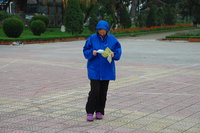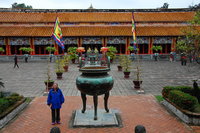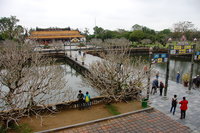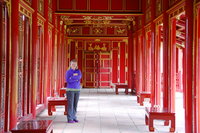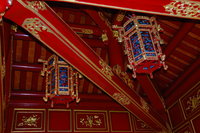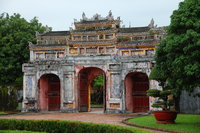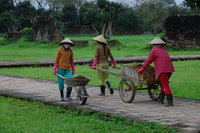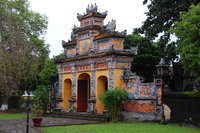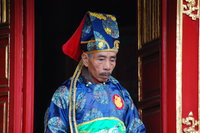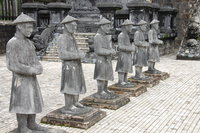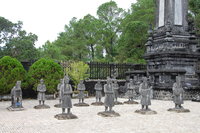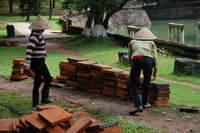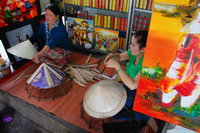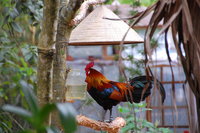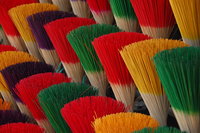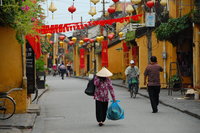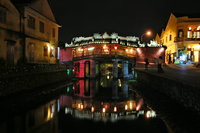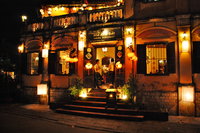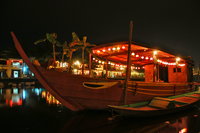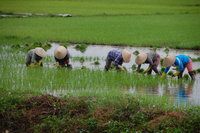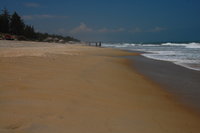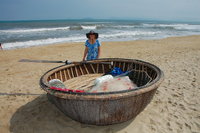The last thing Steve did before departing Saigon was leverage his exemplary bargaining skills to buy a pair of sunglasses from a wandering vendor. From a starting price of £10, he managed to get the street gentleman down to a final price of £1.50 and he is now the proud owner of a new pair of Oakey [sic] glasses.
"The horror...the horror", lamented Brando's Colonel Kurtz in Apocalypse Now. So did we upon landing in Huế to find the place grey, heavily overcast, drizzling and freezing cold. It is amazing (and rather disappointing) what difference an hour's flight can make. It was 37°C in Saigon and it is about 13°C here! We shall not stay long.
Huế
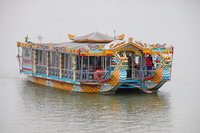
The city of Huế sits on the banks of the Perfume River and, as with the lake at Đà Lạt, this river has its fair share of "Duck Boats". However, in this weather, no one is mad enough to go out in these comedic craft! Being Brits, we did inquire about the weather and, specifically, whether we would be rained on the entire time. As with most inquiries here, we were met with many different responses. Some claimed that it would rain only this week, some that it would last until the end of February and still others that it would rain until the Tết festival began. As usual, our mistake was in asking more than one person.
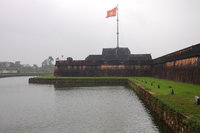
It was common practice throughout the ages in Vietnam for monarchs to declare themselves emperors. It is not clear why they would do this or what advantages it afforded, but this they did.
In 1802, the then Emperor, Gia Long, relocated the country's capital from Hanoi to Huế (pronounced Hway) in an attempt to unify the North and South. A large citadel was built here, but it has had a torrid and somewhat unfortunate history. In 1885 the French attacked the place, burned the imperial library and stole absolutely everything of value. In 1968, during the Tết Offensive, VC forces rather temeritously occupied Huế. In response, the Americans bombed the living daylights out of the city and napalmed the Imperial Citadel. Approximately 10,000 people died in 3½ weeks. The majority were civilians.
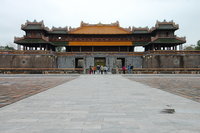
Despite the fact that the Citadel was bombed into oblivion, it is still the star attraction in
Huế and pretty much the main only reason to come here. The complex is surrounded by
2m thick, 10km long walls and a 30m wide moat. Within the outer wall is an inner citadel reserved
for royalty and within that, a further walled citadel reserved only for the emperor. We had
understood that not much is left standing after all that bombing but actually, there are quite a lot
of buildings remaining and extensive restoration work is going on all the time. In fact, some of the
work should really be described as rebuilding, since it seems to be the aim to reconstruct the
entire place as it used to be. It has to be said that the work that has been done to date is rather
impressive. As you would expect where manual labour is concerned, the majority of the work seems to
be being carried out by women. No doubt the men are busy discussing architectural plans in a café
somewhere.
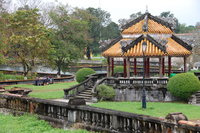
The Citadel is somewhat similar to the Forbidden City in Beijing although not nearly so vast or complete...or crowded! Never the less, we spent nearly an entire day exploring the buildings and gardens - and it didn't even rain.
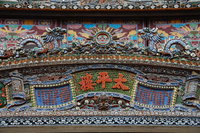
The emperors who lived here were of the Confucian school, which means that a) they laid things out in grid fashion with areas allocated to different functions and b) they ignored the needs of their subjects in pursuit of higher goals. It seems that this latter issue led finally to the abdication of Emperor Bảo Đại to Uncle Ho that we learned about in Đà Lạt. The other effect of the Confucian influence is that all the decoration is in Chinese script, making it appear even more like the Forbidden City. Actually, Chinese script was in use officially in Vietnam until well into the 20th century, so this is not so surprising.
Continuing the emperor theme, given that they all lived here, it is no surprise that they died and are buried here - some in rather elaborate tombs, and these are the other tourist attraction in Huế. We paid a man to drive us to the tombs of some of the more amusingly named emperors to see what all the fuss was about.
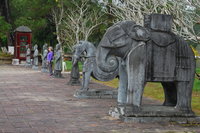
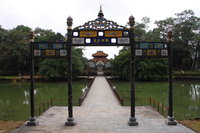
It seems that one of the tasks that befalls an emperor during his reign is to build his own tomb. There is nothing like spending a significant portion of your life constructing your own burial chamber to focus the mind. It also seems that killing the workers after they had built the tomb was quite trendy too! In some cases this was because they didn't like the end result and in others it was an attempt to keep the location of the place a secret.
Someone who put together quite a splendid array of buildings to commemorate their own demise was the amusingly named Emperor Ming Mang. He built lakes and bridges, temples and tombs. The Mangster's complex was probably the most architecturally impressive we saw with some 40 buildings all laid out in a very regular pattern that we would soon recognise at the other tombs we visited. At the front is a so-called Honour Courtyard containing rows of animals and mandarins which is one of the best bits of all the tombs we saw. In fact, Ming Mang did not get to kill any construction workers as he died before the complex was completed and work was completed with his body already interred.
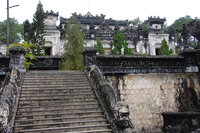
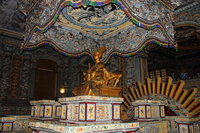
The next tomb belonged to the rather less amusingly named Emperor Khai Dinh who managed to build an impressive tomb complex on the side of a hill. Rather less impressive (for the locals) was the fact that taxes were raised by 30% just to fund the building of the tomb. This is good news for us though as the result is pretty spectacular. The architecture is a blend of Eastern and Western and, due to the black colouration of the stonework, it has rather a Gothic feel on the outside. Inside is another matter, with the entire place decorated with mosaics of glass and ceramic. The whole place took 11 years to build - which is a lot of extra tax!
Finally, we visited the tomb of Tu Duc who was the longest reigning of the emperors and not an American rap artist as you might think. Tu Duc designed a much less impressive tomb which looked rather like a Quake Death-match arena. Don't worry if you don't know what that is, suffice to say, there are some large walled and paved areas containing stone sarcophagi and not much else. The best thing about Tu Duc is not his tomb building skill, but the fact that he named is son "Duc Duc" - which is either incredibly harsh and cruel or rather amusing, depending on whether you are his son or not.
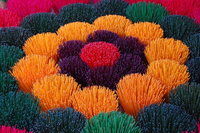
Like the citadel, these tombs are undergoing extensive preservation and restoration work. Also like the citadel, much of this work is being carried out by women.
In our travels around the area, we saw a village populated by people who manufacture the iconic Vietnamese conical hats. This place is imaginatively known as "The Conical Hat Village". We also saw a place where they manufacture incense sticks in all colours and aromas, but we did not catch the name of that village.
We have to leave Huế now because a) the weather is poor (did we mention that) and b) the "which Hway do we go now?" jokes have worn a bit thin. We shall take the train most of the hway to Hội An.
Hội An
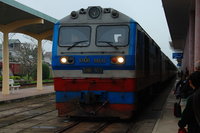
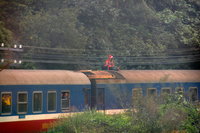
The rather grandiosely named Reunification Express runs the length of the country from Hanoi to Saigon and we picked it up at Huế for the scenic run down to Đà Nẵng (after some 800km, it was still bang on time). On arrival, we had to pay a nice man to drive us the last 30km to Hội An, since the railway does not actually go there (despite the fact that all the people do). We paid a bit extra for the 100km train journey (tickets £2 - each!) for the privilege of auto-reclining [broken] seats and refrigeration rather than air-con. The journey is spectacular, running as it does along the coast at the so-called China beach (where "Charlie don't surf"), but we can't bring you any pictures since it was quite cloudy and/or the windows were quite grimy. This also means that the photo of the man dressed as Santa travelling on our train roof is rather poor. It is testament to the winding nature of the track as it clings to the cliff face that we even managed to spot our festive stow-away.
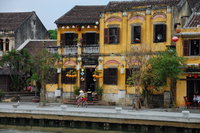
Hội An is a beautiful old town set on the banks of the Thu Bồn river. It is a UNESCO World Heritage Site (where isn't?) and sports a large number of Chinese style shop-houses that reflect its heritage as an old trading port. Nowadays, it is a weird sort of place that has developed a rather unique business model. For large portions of the day, locals are banned from the old, historic part of the town and then tourists are charged to enter, so that they can enjoy the place in peace and quiet. Locals are not truly banned of course, only motorbikes, but the effect is the same. This means that you can walk the streets without fear of being run over, but it also means that everyone you see in the streets is a tourist. This does not detract from the authenticity of the experience as far as we are concerned since 90% of the tourists are Asian anyway. Also, the danger of being run over is not really reduced since bicycles are still permitted and they make no noise and don't flow around you, they just shout for you to move.
Many of the shops in the old town are tailors who will make you a quality suit in 24 hours (exactly what level of quality is left unspecified). These places target their wares at Western tourists, but apparently numbers are declining rapidly due to a) the commercialisation of the town and b) the huge increase in the Asian "mass tourism" package tour. The latter block book the hotels and are more than capable of pricing Westerners out these days. You can see this tourism in effect by the winding chains of cycle-rickshaws ferrying unhappy looking Chinese tourists around the streets.
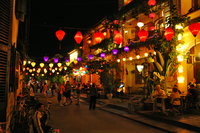
Presumably in some kind of homage to its Chinese origins, the town hangs lanterns everywhere. At night, the town is illuminated by the soft glow from thousands of these paper creations and this has become the signature of Hội An.
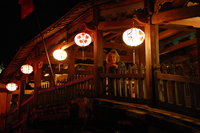
Indeed, one of the highlights of Hội An is wandering the streets in the evenings when all these lanterns and lights are on. All the shops and restaurants hang lanterns outside and the effect is rather mesmerising. Of course, many, many shops will sell you a lantern or two. Rather practically, Megan inquired as to the wattage these lanterns were rated at, which was probably the first time that question had ever been asked here. Enterprising old ladies will sell you a lantern (made from an old food carton and an inch of votive candle) to float down the river. Even more enterprising old ladies wait to collect the dead lanterns at the other end for resale.
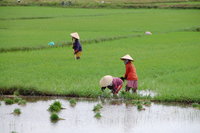
In this place we have to barter hard. The aforementioned Asian tourists are driving prices way up and published prices for most things are eye-watering by local standards and certainly not what we are used to. Game on!
In addition to the town itself, we spent some time cycling around the local countryside on the hotel's comedy bicycles. It was as if we had cycled straight into a travel brochure. We passed regimented vegetable gardens and bucolic paddy fields all the while watching water buffalo and people in pointy hats working. It was a rather idyllic and iconic setting accompanied by the equally iconic repetitive thumping and wailing of karaoke from a nearby village.
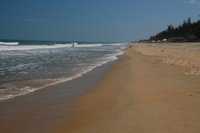
One particular cycling destination of note only a few kilometres from town is the rather spectacular An Bang Beach. This forms part of the infamous China Beach where the Americans went for some R&R between bombing runs. The Vietnamese don't call it China beach, rather Pacific Beach which reflects a general antipathy to all things Chinese (except the tourists). It is incredible these days to find such a fine stretch of beach still backed by banana trees and the odd cabaña selling food and drink. Development seems to have passed this place by, but inclusion in the world's top 50 best beaches must surely mean the developers are not far behind. For the moment, the beach offers mile upon mile of gently curved, perfect sandy beach. At this time of year the sea is a bit choppy and murky, but the temperature and climate are perfect for a relaxing stroll (or multi-mile hike if you have the sand-legs).
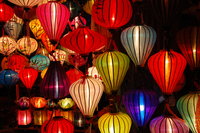
What makes Hội An such a great place to hang out may also be its downfall. Since the streets are so narrow and winding, the motorcycle riders here have taken to blowing their horns quite a lot in that self-important and completely pointless way that is all too common throughout Asia but which was hitherto refreshingly absent in Vietnam. Perhaps a part of it is that they are venting their frustration at being barred from areas of their own town in favour of tourists (although they must realise it would be a pretty poor town without the tourist dollar). As we said earlier, within the old town, everything is hideously over-priced. A meal costs three or four times what it does near our hotel, which is a ten minute walk from the centre. Again, this is the Asian buying power at work.
The last thing Steve did before leaving Hội An was throw the broken Oakey glasses in the bin.
After a cultured and relaxing time in the relative civility of Hội An, next time we head off to Nha Trang; a well-developed beach resort favoured by the Russians. What could possibly go wrong?
Some Pictures
